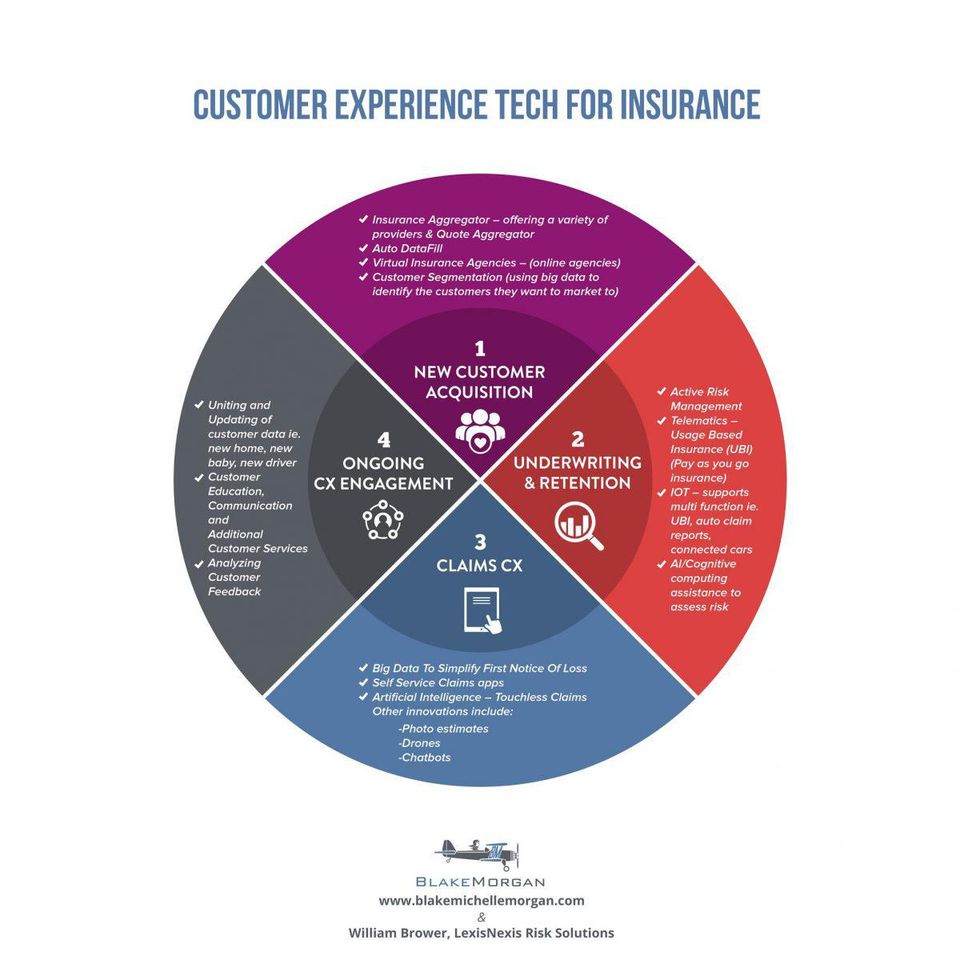
Insurance has long been associated with frustration. From the slow underwriting process to the lengthy experience of getting a claim filed to the lack of data and analytics being used to personalize and tailor the customer experience, insurance is ripe for disruption.
I frequently discuss the potential for insurance and disruption with William Brower, VP, product management – claims at LexisNexis Risk Solutions. Together we created a framework to show what is possible with technology. There’s potential for insurance, whether it’s an operating system for claims like GuideWire or using drones to assess damage. Insurance is often referred to as a dinosaur industry, but perhaps now we will see insurance change its ways with advances in technology.
“Customer expectations have changed dramatically over recent years with the advancement of technology, data and advanced analytics,” Brower says. “Insurance companies are working hard to understand which technology and what data and analytics to implement to meet or exceed customer expectations.”
Insurance is an industry based on trust—the customer pays a subscription believing if they do business with a certain company they will feel the value of that business later. Customer experience is at the root of that trust, and a large part of today’s experience comes from technology. However, only 15% of customers say they are satisfied with their insurer’s digital experience.
With an increasing amount of natural disasters and rising costs for insurance companies, how business has been done for decades simply doesn’t cut it anymore. In order to compete, businesses across all industries, especially insurance, need to become experience-led and make their customers’ lives easier and better with technology.
As Brower says, there are multiple touch points like attracting a new customer and underwriting the risk, effectively handling claims, and maintaining a great long-term relationship with the customer. Companies that excel in all four phases will enjoy a significant competitive advantage for customer growth and profitability. These four phases are echoed in our insurance tech framework.

Download framework here for a better view
1. New Customer Acquisition
Technology allows insurers to be smarter and more strategic about how they reach out to new customers. From insurance aggregators that offer a variety of products to customer segmentation that uses data to know which customers to reach out to, technology makes customer acquisition less of a shot in the dark and more strategic. This is shown with the growth of online insurers, especially given that millennials are twice as likely to purchase insurance online than other generations.
Digital technology and data give insurers the chance to know their customers better. That means they can price and underwrite more accurately and better identify fraudulent claims.
2. Underwriting and Retention
In the insurance world, money comes in through agents and leaves via claims. Agents can use data to have information about customers like their home history and auto insurance records before they begin the underwriting process.
One of the challenges of underwriting is knowing how much to charge to avoid making adjustments within six months or a year. Technology like active risk management telematics use data to calculate accurate policies. Many car insurers offer customers telematics devices to put in their cars to track how much they are driving and how safe they are. Other companies offer usage-based insurance that allows customers to pay as they go. Flexibility and customization helps create a more accurate underwriting process that retains customers.
3. Claims CX
Claims are often seen as the place where insurers lose money, but with technology it’s actually possible for claims to help make money. Auto insurers who provide consistent best-in-class experiences generate 2-4 times more growth and see 30% higher profitability. Automation can reduce the cost of a claims journey by as must as 30%.
Technology can improve every aspect of the claims process. Using pre-populated claims forms and apps makes it easier for customers to submit information without having to answer repetitive questions. Technology also introduces new ways to interact, such as agents texting customers with status updates. Even small things like paying claims electronically instead of by check can make a difference for customers and make their lives easier.
In the traditional way of handling claims, a homeowner would file for a roof replacement after a hail storm, and a claims adjuster would drive to their house and climb on the roof to measure the damage. With new technology, much of the risk is removed as insurers work with specialists who take pictures and videos. LexisNexis has even created a drone solution that uses licensed drone pilots to detect property damage. The adjuster then looks at the images and aerial footage to examine the damage more quickly, safely, and accurately.
It’s typical for a customer to never talk to the same insurance person twice. The more times a customer needs to talk to a person, the more frustrated they become with the claims process. People want results and to have their issues fixed quickly. Many companies are incorporating live chat so their customers can get answers right away through video chat or chatbot. If a customer files a claim, some agents even connect via FaceTime.
Automation has been underway for a few years in the new customer acquisition, underwriting, and retention phases. The claims process automation is really just getting started. As Brower says, “While all four phases are focused on leveraging technology to improve the customer experience, we will see more rapid changes coming to the claims space over the next couple of years, as that is the highest priority area for many insurers today.”
4. Ongoing CX Engagement
Insurance is about building relationships with customers. Technology and IOT devices can unite updated customer information to know when customers have a new home, a new baby, or a new driver. Staying on top of communication allows insurers to more successfully engage with customers and offer additional services.
It tends to be that bigger companies have more fragmented communication. Even large companies can aim for customization and the personalized touch of a smaller insurance company. Big data can also be used to analyze customer feedback to be constantly improving.
Insurers should not underestimate the changes that digital will bring to their industry and the significant profit improvements that are within their grasp if they don’t shy away from the exciting future unfolding for the industry. If they act decisively, they will be among its leaders. Technology has the power to transform the insurance industry and provide new opportunities, if only insurers will take the risk and make the change.
Blake Morgan is a customer experience futurist, author of More Is More, and keynote speaker. Sign up for her weekly newsletter here. Go farther and create knock your socks-off customer experiences in your organization by enrolling in her new Customer Experience School.

